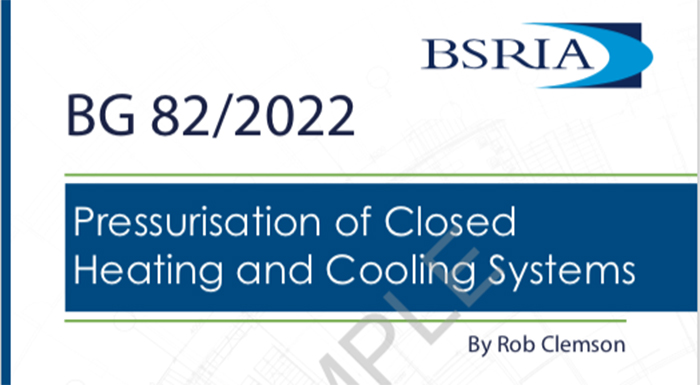Pressurisation of Closed Heating and Cooling Systems (BG 82/2022)
The maintenance of acceptable pressures whilst accommodating thermal expansion is one of the key factors in ensuring continuous and correct functioning of heating and cooling in buildings. Correct pressurisation prevents system failures, thus saving building owners time and cost related to system downtime and repairs.
Contents |
[edit] BSRIA launch
Pressurisation of Closed Heating and Cooling Systems (BG 82/2022)
This guide explains the principles of pressurisation, the different types of equipment used, and the calculation procedures following both British and European standards. The guide has been developed with a steering group of industry experts, following discussions on the importance of pressurisation, in the context of closed heating and cooling systems. Correct pressurisation prevents system failures, thus saving building owners time and cost related to system downtime and repairs.
[edit] Overview
In the context of closed heating and cooling systems, the term pressurisation covers:
- Maintaining system pressure within acceptable limits
- Accommodation of thermal expansion and contraction
- The application of safety devices
It may also include automatic top-up of system water and initial system filling.
[edit] Product details
Published: November 2022
Publisher: BSRIA
Author: Rob Clemson
ISBN: 978-0-86022-796-0
This article appears as "Pressurisation of Closed Heating and Cooling Systems (BG 82/2022)" on the BSRIA knowledge and bookshop website dated November 2022.
--BSRIA
[edit] Related articles on Designing Buildings
- Air handling unit.
- Active pressurisation.
- Boiler markets and the green recovery.
- Building heating systems.
- Building services.
- Cooling plant
- Corrosion in heating and cooling systems.
- Fan coil unit.
- Heat meter.
- Heat pump.
- Heating controls.
- HVAC.
- Radiant heating.
- Thermal comfort.
- Types of domestic heating system.
Featured articles and news
A change to adoptive architecture
Effects of global weather warming on architectural detailing, material choice and human interaction.
How big is the problem and what can we do to mitigate the effects?
Overheating guidance and tools for building designers
A number of cool guides to help with the heat.
The UK's Modern Industrial Strategy: A 10 year plan
Previous consultation criticism, current key elements and general support with some persisting reservations.
Building Safety Regulator reforms
New roles, new staff and a new fast track service pave the way for a single construction regulator.
Architectural Technologist CPDs and Communications
CIAT CPD… and how you can do it!
Cooling centres and cool spaces
Managing extreme heat in cities by directing the public to places for heat stress relief and water sources.
Winter gardens: A brief history and warm variations
Extending the season with glass in different forms and terms.
Restoring Great Yarmouth's Winter Gardens
Transforming one of the least sustainable constructions imaginable.
Construction Skills Mission Board launch sector drive
Newly formed government and industry collaboration set strategy for recruiting an additional 100,000 construction workers a year.
New Architects Code comes into effect in September 2025
ARB Architects Code of Conduct and Practice available with ongoing consultation regarding guidance.
Welsh Skills Body (Medr) launches ambitious plan
The new skills body brings together funding and regulation of tertiary education and research for the devolved nation.
Paul Gandy FCIOB announced as next CIOB President
Former Tilbury Douglas CEO takes helm.
UK Infrastructure: A 10 Year Strategy. In brief with reactions
With the National Infrastructure and Service Transformation Authority (NISTA).
Ebenezer Howard: inventor of the garden city. Book review.
Airtightness Topic Guide BSRIA TG 27/2025
Explaining the basics of airtightness, what it is, why it's important, when it's required and how it's carried out.
























Comments
[edit] To make a comment about this article, click 'Add a comment' above. Separate your comments from any existing comments by inserting a horizontal line.